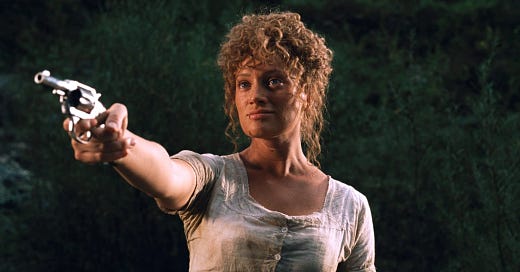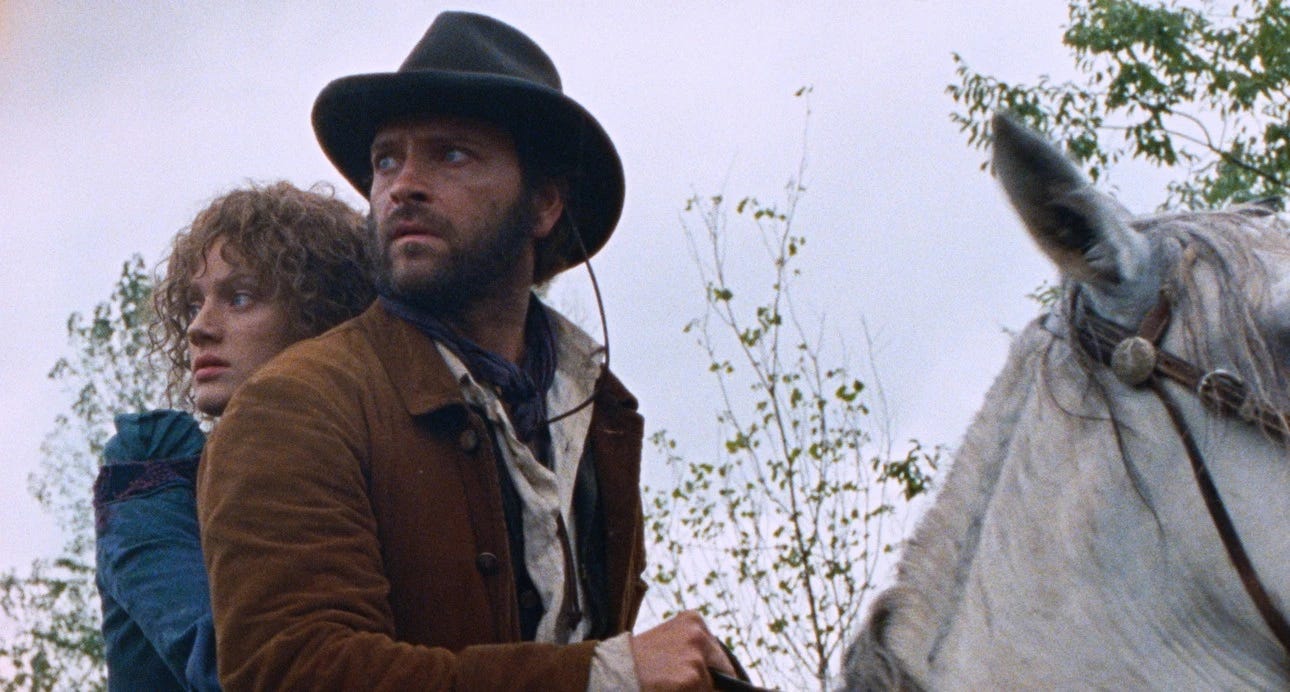Dos faroestes clássicos, sempre conservo a memória do vaqueiro ou xerife cavalgando em direção ao sol. Essa figura que traria a ordem e a civilização, ao custo da violência, e depois desmistificada nos faroestes revisionistas e espaguete, está no centro de Head or Tails, juntamente com a figura da mulher, que representaria o desejo do imigrante e do colono em se estabelecer naquela terra recém conquistada (cof cof, tomada mesmo) e constituir uma família. Essas convenções foram reviradas pela dupla Matteo Zoppis e Alessio Rigo de Righi, em uma narrativa divertida e charmosa, e ainda assim clichê e redundante.
Quando o roteiro tem início, Buffalo Bill Cody (John C. Reilly) trouxe à Itália a história e tradição do faroeste dos Estados Unidos - um aceno à evolução do gênero, depois de deixar de ser refém do protagonismo de John Wayne, e descobrir a voz de uma geração em Clint Eastwood. Então, Rosa (Nadia Tereszkiewicz), a infeliz esposa de um dono de terras poderoso, é ‘sequestrada’ pelo vaqueiro Santino (Alessandro Borghi), e Buffalo é convocado para resgatá-la. Rivalizando os caubóis estadunidenses e italianos, como se estivesse tentando provar quem fez melhor no gênero, a direção ainda investe em uma discussão sobre o papel da violência na construção e desenvolvimento estadunidense, e como esta mesma violência, após a civilização, tornou-se um motivo recorrente para a violência que agora entretém.
Não há nada de inédito em revelar que o violento, o selvagem, ou o bárbaro, não são os povos indígenas que antagonizam o herói das aventuras contadas pro Buffalo Bill, mas os donos de terra brancos, cuja ganância é tão implacável quanto os trens que cruzam as estradas de ferro levando o interesse próprio de carona com o progresso econômico e a destruição da fábrica da sociedade originária que antes habitava aquela região. Tão derivada é também a relação construída entre Santino e Rosa, e até a reação de Buffalo Bill, cuja vivência o capacitou a compreender o desejo de vingança do Sr. Rupè (Gianni Garko). Mesmo que a estrada por que atravessam os personagens tenha sido revisitada tantas vezes que não pareça trazer maiores surpresas, o roteiro consciente da história secular do gênero ainda encontra espaço para reviravoltas.
A dupla de diretores brinca de fazer faroeste, e mesmo que não criem nada de novo, é gostoso o aceno a subgêneros clássico, espaguete, zapata - quando realizam as críticas sociais, a ênfase no pré-capitalismo -, cômico - de Terence Hill e Bud Spencer, e afins - até absurdo e surreal, com alternativas na trama que renovam o pacto de suspensão de descrença do espectador. O cinema tem lá esse charme, quando o tempo passa e os gêneros amadurecem além de fórmulas iniciais, transformam-se em outras ‘criaturas’ jamais imaginadas no passado e que agora são perfeitamente aceitáveis, e estimulam outras formas de relacionamento do espectador com o material que está assistindo.
Pode não ter nada de novo, embora isso não seja necessariamente ruim: John C. Reilly continua despretensiosamente charmoso e bonachão, construindo a personalidade de Buffalo Bill nem como antagonista, nem como justiceiro, mas como documentador de eventos que se desenrolarão, quer ele deseje ou não. Já Nadia Tereszkiewicz é altiva e voluntariosa, no tipo de heroína contemporânea que não depende de autorização para agir do jeito que deseja agir - naturalmente que dentro das limitações que a situação e as circunstâncias impõem. Não é nada inédito, bom frisar, mas é agradável o bastante para manter a atenção, ainda mais para que for fã do ritmo característico do faroeste e admirar a direção de fotografia chapiscada e expansiva deste velho oeste, em um filme ora clássico, sempre revisionista, e até mesmo absurdo e surreal.
Head or Tails está na mostra Um Certo Olhar do Festival de Cannes de 2025.
English Review
Of the classic Westerns, I always remember the cowboy or sheriff riding toward the sun. This figure who would bring order and civilization, at the cost of violence, and later demystified in revisionist and spaghetti Westerns, is at the center of Head or Tails, along with the figure of the woman, who would represent the desire of the immigrant and the settler to settle in that newly conquered land (taken, indeed) and start a family. These conventions were turned upside down by the duo Matteo Zoppis and Alessio Rigo de Righi, in a narrative that is fun and charming, yet cliché and redundant.
When the script begins, Buffalo Bill Cody (John C. Reilly) has brought the history and tradition of the American Western to Italy - a nod to the evolution of the genre, after it stopped being held hostage by the leading role of John Wayne, and discovered the voice of a generation in Clint Eastwood. Then, Rosa (Nadia Tereszkiewicz), the unhappy wife of a powerful landowner, is ‘kidnapped’ by the cowboy Santino (Alessandro Borghi), and Buffalo is called to rescue her. Rivaling American and Italian cowboys, as if trying to prove who did it better in the genre, the director also invests in a discussion about the role of violence in the construction and development of the United States, and how this same violence, after civilization, became a recurring motive for the violence that now entertains.
There is nothing new in revealing that the violent, the savage, or the barbarian, are not the indigenous peoples who antagonize the hero of the adventures told by Buffalo Bill, but the white landowners, whose greed is as relentless as the trains that cross the railroads, taking their own interests along with economic progress and the destruction of the fabric of the original society that once inhabited that region. The relationship between Santino and Rosa is also so derivative, as is Buffalo Bill's reaction, whose experience has enabled him to understand Mr. Rupè's (Gianni Garko) desire for revenge. Even though the path the characters travel has been revisited so many times that it doesn't seem to bring any major surprises, the script, aware of the genre's centuries-old history, still finds room for twists and turns.
The directing duo plays at making a Western, and even though they don't create anything new, it's nice to nod to classic subgenres, such as spaghetti, zapata - when they make social criticisms, the emphasis on pre-capitalism -, comedy - by Terence Hill and Bud Spencer, and the like - even absurd and surreal, with alternatives in the plot that renew the viewer's suspension of disbelief pact. Cinema has this charm, when time passes and genres mature beyond their initial formulas, they transform into other ‘creatures’ never imagined in the past and that are now perfectly acceptable, and encourage other ways for the viewer to relate to the material they are watching.
It may not be anything new, although that is not necessarily a bad thing: John C. Reilly continues to be unpretentiously charming and good-natured, building the personality of Buffalo Bill neither as an antagonist nor as a vigilante, but as a documenter of events that will unfold, whether he wants them to or not. Nadia Tereszkiewicz, on the other hand, is proud and willful, the kind of contemporary heroine who does not depend on permission to act the way she wants to act - naturally within the limitations that the situation and circumstances impose. It's nothing new, it's worth noting for the last time, but it's pleasant enough to keep your attention, especially for those who are fans of the characteristic rhythm of the western and admire the rough and expansive photography of this old west, in a film that is sometimes classic, always revisionist, and even absurd and surreal.






